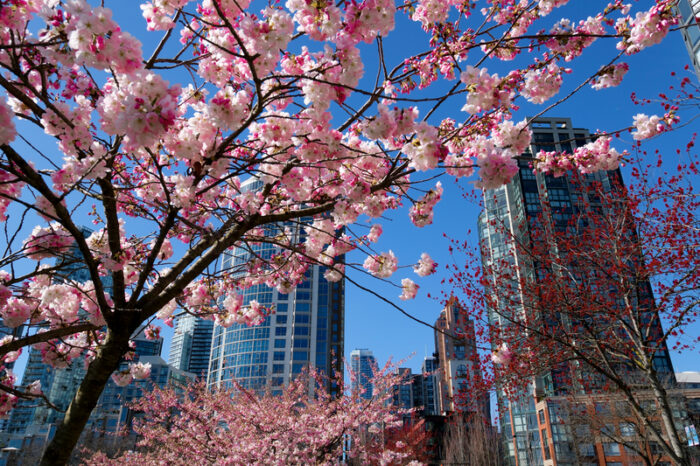It has been an early spring across some parts of Canada.
For example, in mid-April much of Ontario saw record-breaking warmth, with it almost feeling like late June. And all of that warmth meant that many trees and flowers got a head start.
In particular, the cherry blossoms, which are the flowers of the Japanese cherry, or sakura, tree.
Anywhere that these trees are found, people are guaranteed to follow. From Dartmouth Commons in Dartmouth to High Park in Toronto, Westmount Park in Montreal to Stanley Park in Vancouver, the blossoming sakura trees are a sight to behold.
On one hand, it makes sense—flowers are beautiful and who isn't excited to get out and enjoy the warm weather after months of cold? But why these blossoms? What makes them so special that crowds arrive in the thousands and even cause traffic jams?
As it turns out, there are a few reasons why. Let's have a look ...
Spring has sprung
This sign at Toronto's High Park warns people that cars aren't allowed around the cherry blossoms. Cherry blossom season is different depending on where you live. In a place like Vancouver, it is late March, while Toronto is late April/early May. (Getty Embed)
When it comes to signs of spring, cherry blossoms are a pretty strong one.
Though they're not always the first flowers to bloom, they're up there. And they prefer a decent stretch of warmer weather to get going, not just a couple warm days.
So even though springtime can be full of false starts, once the cherry blossoms have arrived, it usually means that warmer weather really is back to stay!
Don't blink!
Cherry blossoms fall quickly and pretty much all at once. (Getty Embed)
But just because spring is settling in, that doesn't mean that the blossoms will. In fact, cherry blossoms are very short-lived.
Peak bloom period (the time when the most blooms are on display) can be as short as four days, and rarely reaches ten days. So once the blooms arrive, you'll probably only have one, maybe two good weekends of cherry blossom viewing.
After that, those lovely petals will suddenly tumble to the ground, gone for another year.
They're really beautiful
Cherry blossoms in London, England. (Getty Embed)
Flowers, schmowers, you say? No one who saw cherry blossoms in person would say that!
These flowers seem to explode all across the tree, as though the branches were covered in very eye-catching pink and white leaves.
At their peak, an orchard of Japanese cherry trees in bloom look like a row of cotton candy clouds hovering a few feet above the ground. How irresistible does that sound?
And they're really meaningful
Sakuras blooming in Tokyo, Japan. (Getty Embed)
But maybe the biggest draw of the cherry blossom season is that it is a really meaningful moment for many people, particularly the Japanese.
In Japan, sakuras are not only a symbol of spring, but of renewal and the shortness of life. They are a reminder to appreciate everything that we have in our lives, because nothing lasts forever.
But seeing the blossoms is far from a sombre occasion. Instead, they inspire celebrations known as hanami (meaning "watching flowers"). People gather under the sakuras with picnic meals and throw a party. Schools and offices hold hanami gatherings, too, as a way to bond with others.
And it's not just the Japanese. People will travel from all over the world to Japan just to witness the blossoms for themselves.
Thanks for the gift!
Just a few of the thousands of cherry blossom trees in Washington, D.C. (Getty Embed)
Thankfully though, these days we don't need to travel that far to witness this beautiful event. The sakura is so significant to Japanese culture that the trees have often been given as gifts to other countries.
In 1912, the Japanese city of Yokohoma sent over 3,000 trees to Washington, D.C. as a gift to the American people.
Most of the sakuras in Toronto's High Park were a gift from the Japanese ambassador on behalf of Tokyo 60 years ago. In Buchart Gardens in Victoria, B.C., the cherry blossom trees came from Japan in 1936.
And in Kariya Park in Mississauga, Ontario, you'll find 80 trees that were a gift to them from their sister city: Kariya, Japan. (And yes, there is a Mississauga Park in Kariya—it even features a large maple leaf tower!)
Viewing cherry blossoms at night is called yozakura. (Getty Embed)
Depending on where you live, the cherry blossoms might be happening, well, right now. If you have the chance to see them in person, we really recommend it!
 Cherry blossoms in downtown Vancouver, B.C. (ID 273988509 © Oleksandra Kharkova | Dreamstime.com)
Cherry blossoms in downtown Vancouver, B.C. (ID 273988509 © Oleksandra Kharkova | Dreamstime.com)









